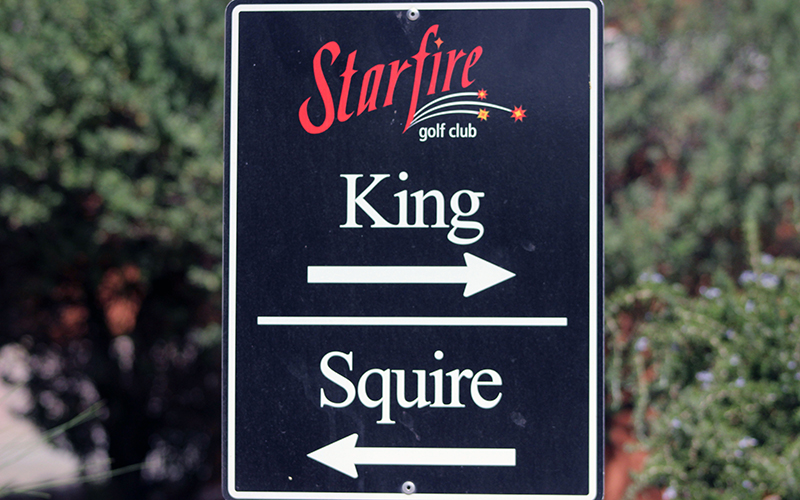
The King course is a 9-hole course at Starfire golf club in Scottsdale that Arnold Palmer designed. (Photo by Nicole Vasquez/Cronkite News)
SCOTTSDALE – In the entrance of the Starfire Golf Club, legend Arnold Palmer smiles in a blue beret while sinking his winning putt in the 1961 British Open – his first of two.
“It’s Palmer by a Stroke,” the “New World” headline reads, one of many documenting the victories he achieved in his 52 years striding the fairway as a “determined, bronzed giant with a Marlon Brando profile.”
At age 87, the King, as he was fondly known, passed away in Pittsburgh on Sunday afternoon. Yet he still beams that boyish grin at golfers headed to the course that he designed.
“He’s a father figure to golfers,” said Mike McGuire, the assistant pro at Starfire.”Even those who drink his drink now know his legacy and what he’s left behind.”
The same year he took home his first Claret Jug, Palmer created Arnold Palmer Enterprises, under which he supervised the design of 300 new or remodeled golf courses. That feat landed him the Donald Ross Award for lifetime achievement, given by the American Society of Golf Course Architects.
Palmer left his imprint on five courses in Arizona – Starfire one of three in the Valley. Two more reside in Tucson and Yuma.
In 1986, shortly after Scottsdale Country Club was renamed Starfire, Palmer remolded two of Starfire’s nine-hole layouts, The Squire and The Hawk, but designed from scratch the third – The King, located on Starfire’s east side,
As a kid growing up in Los Angeles, McGuire witnessed the sandy blond hair, the cool persistence, the loyalty of Arnie’s Army – Palmer’s troop of supporters. His father helped produce past Los Angeles Opens and served as an analyst on the first tee.
“I’d watch the way he interacted with my father,” McGuire said. “He’s personal, always looking you straight in the eye. I went through my father’s Rolodex one day and I was blown away of all the people like Palmer that he had contact with.”
Now, he frequently plays on the golf legend’s lawn.
“For such a compact area, in between the houses, it’s a great design,” McGuire said. “It’s hard to do that in minimal space. The placements of the holes, where to put the bunkers, he puts them in the right places to challenge the golfer.”
Ten miles away at Wildfire Golf Club in Phoenix, club pro Erik Barden recalls Palmer’s style – the 5-foot-10 U.S. Coast Guard body, towering over the tee, his eye moving right to left.
“He played a right to left draw, so his holes bend right to left,” Barden said. “He liked to hit a draw so he designed his golf course how he liked to hit.”
Wildfire consists of two 18-hole courses, one an Arnold Palmer Signature course.
The association of Arnold Palmer’s name on the five renowned courses draws golf lovers of all ages to the desert courses.
“When you have a Palmer signature golf course, people flock to that golf course,” Barden said. “They know it’s going to be top-end, his signature is on it, and when his signature is on something it means it’s awesome. It’s got his touch, his personality.”
That signature, slanted so effortlessly and legibly to the right, has found its way on Arizona ice tea and lemonade cans and the memorabilia golf clubs and bags in the homes of Arnie’s Army members.
“One of the things he used to say was, ‘If you’re going to sign something, make sure it’s legible,'” Barden said. “That’s probably the only thing I didn’t emulate. My signature you can’t read.”
After hearing the news of Palmer’s death, PGA Tour golfer Billy Mayfair, an ASU national champion in golf, thought about all the memorable moments he had with Palmer.
In 1988, after becoming the United States Amateur champion, he was paired with Palmer on the second day of the Masters. On that Friday, Mayfair let Palmer walk to the greens first, but on the 18th hole Palmer shook things up.
“He told me, ‘Get over here,’ and we walked up to the 18th green together at Augusta,” said Mayfair. “He put his arm around me and that to me was very special and touching moment in my life – it meant a lot.”
A four-time Masters champion, Palmer helped make Arizona the golf destination it is today.
“As he helped get golf on TV, he helped the Phoenix Open come to Arizona,” Mayfair said. “If he would not have come and played here, then probably the Phoenix Open wouldn’t be what it is today.”